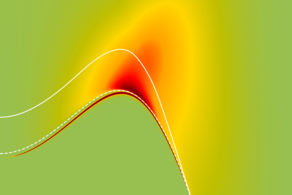Physicist solved the puzzle of long ranged interactions between spins in In(Ga)As quantum dots
- Anders

Quantum computers, unlike classical computers, utilised a superposition of quantum states. One approach to implement a qubit, the elementary unit of a quantum computer, is to confine spins, the magnetic moments of electrons, in semiconductor quantum dots and to use laser pulses to coherently control their alignments. In 2011, experiment on spins in In(Ga)As quantum dots showed that there is an interaction between the spins despite the large distance between the quantum dots [1]. "It is indispensable to understand this interaction in order to think about possible applications," Prof. Dr. Frithjof Anders explains. This might allow to control electronically the interaction strength.
Since the quantum dots are located on a wetting layer, which is formed during the sample fabrication process, the indirect Ruderman-Kittel-Kasuya-Yosida (RKKY) interaction mediated via this layer became a promising candidate. The team proposed a new microscopic model based on charge fluctuations and calculated the effective distance dependent interaction strength between two spins using the numerical renormalization group method. The results were used
in an elaborate simulation of the spin dynamics in up to 10000 quantum dots. "We found a very good agreement between the experimental and theoretical results," Frederik Vonhoff summarizes.
[1] Spatzek et al., Phys. Rev. Lett. 107, 137402 (2011)
Frederik Vonhoff, Andreas Fischer, Kira Deltenre, and Frithjof B. Anders, Phys. Rev. Lett. 129, 167701 (2022)







